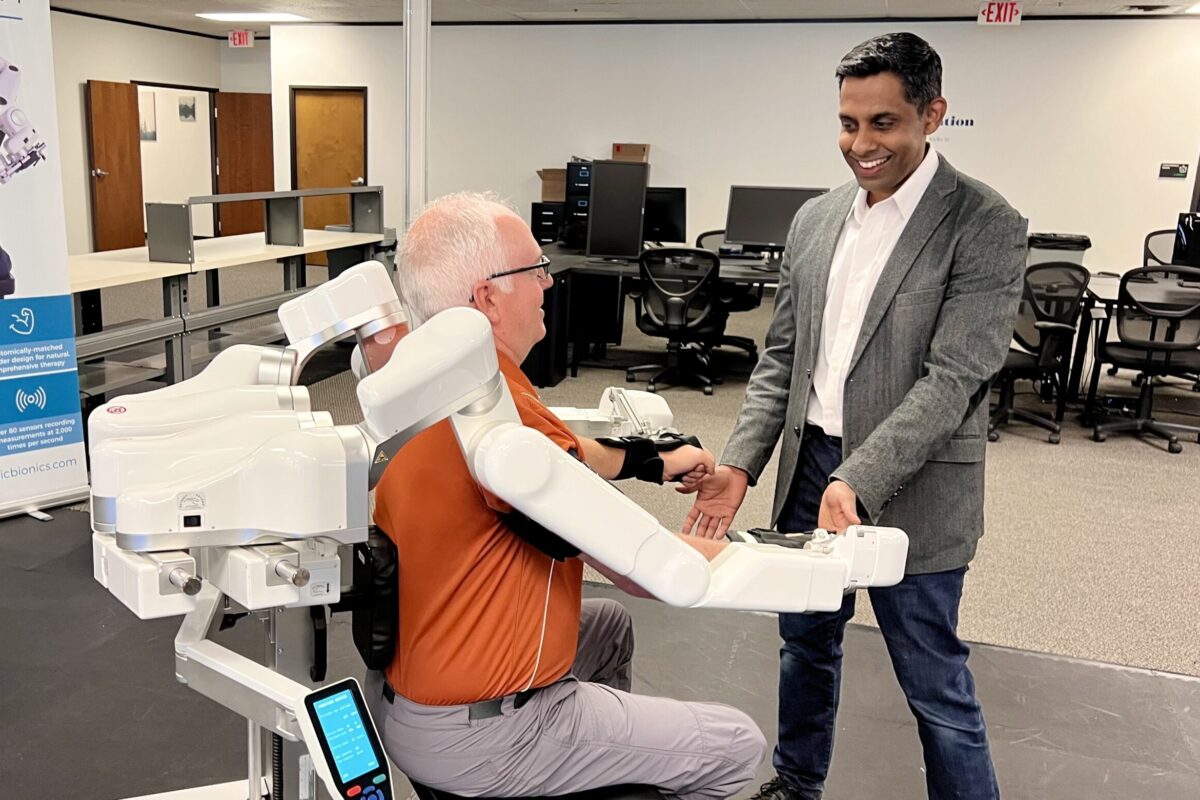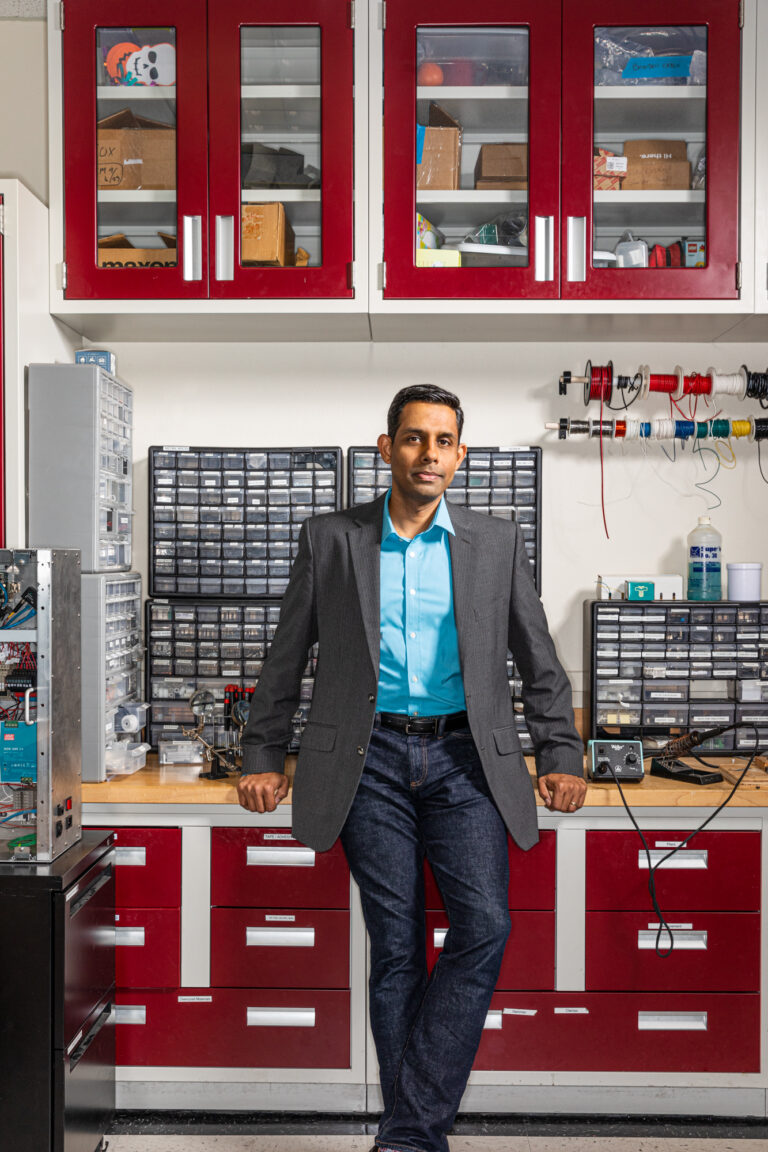
I write about faculty members at The University of Texas at Austin for a living. Most of the time I remain out of sight, acting as the invisible “fourth wall,” to borrow a term from theater and film. But Ashish Deshpande and I have a backstory that’s relevant to his work. So writing about him without telling you how we first met seems a bit — well, robotic.
On Jan. 19, 2018, I was at work in Walter Webb Hall, where UT’s communications team then had its office, when my right hip began to buckle with each step. Within three minutes, I was sitting on the floor, no longer able to walk or move my right arm. At 50 years old, out of the blue, I was having a major hemorrhagic stroke. That evening at UT’s Dell Seton Medical Center, brain surgeons stopped the bleeding and probably saved my life.
After 10 weeks in hospitals and rehab centers, I was invited to join a study involving a robotic set of motorized arms that could take my upper body through a range of motions that were now impossible on my own. I agreed, and that is when I met Ashish Deshpande, then an associate professor in UT’s Walker Department of Mechanical Engineering and creator of this device, known as Harmony.
After my hands and arms were connected to the robotic arms, which look a bit like stormtrooper armor from Star Wars, one of Deshpande’s Ph.D. students hit a few keys at a computer, and the robot went slack, supporting the weight of my arms but not controlling the direction. My arms were effectively floating in zero gravity.
I then proceeded to use what little strength I had to move my nearly paralyzed arm through six motions at the student’s direction. If I initiated the move in the right direction, Harmony rewarded the effort by assisting me through the rest of the motion, its tiny motors whirring and conjuring up all sorts of science-fiction references. At the end of the study’s 12 sessions, the team surprised me with a new trick — mirror mode — in which anything I did with my strong arm Harmony mirrored with my weak one. After months of stiffness and soreness due to the lack of motion of my weak arm and shoulder, suddenly I felt whole and symmetrical again, if just for a few glorious minutes.
It has been about five years since that study, and when Deshpande recently was promoted to full professor, I visited him again to learn more about his work with stroke survivors and how it was that he came to UT.
I found him in a new lab, which he shares with other faculty members, known as Texas Robotics in a beautifully converted historic gymnasium, Anna Hiss Gym. Work cubicles and machine shops sit on the gym’s old hardwood floor, and the huge arched windows of the 1930s building let in abundant daylight.

Deshpande grew up in Nagpur, India, a city the size of Houston. His father was an agriculture extension officer who grew up in a village. “He always tells me that him coming to the city was as big as me moving to America,” Deshpande says.
A notable feature of the professor’s life has been the constant presence of strong women: a grandmother who was the family matriarch, a mother who was a high school science and math teacher, two older sisters, and now a wife and daughter, along with a son. “I am lucky to be surrounded and guided by these strong women,” he says with a smile. “I just follow their lead — I’m good at that.”
One of his sisters is an occupational therapist who treats patients with neurological injuries, including strokes, and he credits her work, as well as his mother’s sense of service to others, with turning his interest in robotics toward improving rehabilitation. “‘What is your life’s mission beyond personal gains? Are you helping people?’ I always heard that from my mother.”
After finishing his bachelor’s degree at his hometown university, he found himself at a crossroads. He had a job offer from Bajaj Auto, one of the largest automotive manufacturers in the world, and had been admitted to graduate school at the University of Massachusetts Amherst. A phone call from the professor with whom he wanted to study tipped the scales. He recalls his first flight at age 20, his first time seeing snow, and new friends who took him to the Burlington Coat Factory for a proper jacket.
His decision to pursue a Ph.D. at the University of Michigan was the first truly conscious choice of his career; all his previous moves were simply defined by his circumstances. “I liked the ideation, diving deep, all the math around it, but also communication and writing.” He loves literature, especially old classics in his local language, Marathi. Most of all, he loved the incredible developing technology. But something was missing. It lacked the human element, and he wanted his research to focus directly on helping people. Academic freedom allowed him to direct his research toward serving a need he saw.
A postdoctoral fellowship at the University of Washington helped him combine his passions for research and helping people. Some 800,000 Americans have a stroke each year. What could he do for these patients who are left with serious disabilities? His first faculty position, at the University of Maine, required him to focus more intensely — to build a lab, direct graduate students and get funding. There, he met Elizabeth DePoy, a professor of disability studies in their social work school, and she was the inspiration for Harmony. “She was inspiring me and others on the faculty to look at the needs of people with disabilities holistically,” he remembers. They were not thinking about rehabilitation, but only exercise machines for people with disabilities. “Initially we thought of this as a rowing machine for people with arm and hand disabilities.”
When he came to UT in 2011, he began focusing increasingly on stroke. He felt he was complicating matters by combining the upper and lower body, so he decided to focus only on the upper body. Two years after Harmony, he launched Maestro, a similar robotic interface to rehabilitate hands.
Why did he and his wife, biology professor Shalene Jha, pick UT? They were deciding between Yale, Tulane, UC-Irvine, Central Florida and UT, and it was Texas’s prestige and rankings that tipped the scales in its favor. “We loved the campus and the facilities. I liked the department vibe during the interview, and I had good faculty mentors. We could see ourselves right away living in Austin.” More recently they had an opportunity to go to the University of California, Berkeley that they passed on. “I have not regretted coming to UT for a single moment,” he says. “I get to work with amazing students and really good colleagues.”
***
I asked Deshpande, now 12 years into the Harmony project, what he could report in the way of successes, and his answer revealed the painstaking and incremental reality of the research in which I participated. He sees it in two phases. “Phase one is building a device that is a research platform that has lots of features allowing us to ask interesting, difficult questions, and we’ve done that.” Those questions include: Can they build a robot that is safe, that can move different parts of the body, that can measure all these different forces, and that can be highly responsive, so if the survivor can do something, the robot does not do that? “I think we have successfully accomplished that,” he said. “We’re very happy with it.” The team has shown that Harmony can help deliver therapy not only in a lab but also in a hospital setting, and there is a huge potential to improve outcomes.
The phase two question is challenging but also more exciting and is where the rubber meets the road: Can Harmony help therapists deliver treatment that leads to full recovery? “All that is on the table right now. We are tackling tough questions that might lead to a significant breakthrough.”
Getting those results will involve intense collaboration with experts in two other fields. He sees his research as a three-legged stool: robotics; therapists and medical doctors; and neuroscientists. Therapists are thinking in practical terms about protocols. Neuroscientists are thinking first about the mechanism of the injury and then the mechanism of recovery. How does physically moving the body cause neuronal growth? “I’m in the service of both of them,” he says.
"DESHPANDE AND HIS WIFE WERE DECIDING BETWEEN YALE, TULANE, UC-IRVINE, CENTRAL FLORIDA AND UT, AND IT WAS TEXAS’S PRESTIGE AND RANKINGS THAT TIPPED THE SCALES IN ITS FAVOR."
There are two distinct phenomena, he says, that can follow a stroke: compensation and recovery. “You know from your own life that you can compensate by using the side that works,” he told me. Very true, as I type all this with my left hand. “The surprising part is that true recovery can happen for a lot of people. We don’t know how to get there, but there’s potential.”
Neuro-recovery is the next level and where the hope lies. “There is actually growth of the axons into the dead zone. It’s almost like when a child is born. There is growth and new connection, and there is even disconnection. Sometimes you don’t want connection because those connections make it messier.”
However, the window in which that new growth happens can be brief. In my case, notable gains happened within six months, with a complete “plateau” reached at about a year. “Some people have spontaneous recovery during that phase, which is a complete mystery to us,” he says. “To use robots to really dig into those questions is the next phase for us.”
What’s more, my own therapy protocols encouraged daily repetitions of movements in the hundreds and thousands. So for Harmony’s efficacy to really be known, the robots will need to be in rehab hospital gyms for frequent and prolonged use, if not even in hospital rooms, so that patients can start using them as soon as physically possible, when the brain is aggressively regrowing nerves and searching for workarounds.
The beauty of research at UT, Deshpande says, is that, “I have full freedom to pursue my research. No one comes into my office and says, ‘Tell me all the topics! Do this! Don’t do that.’ Never. You’re encouraged to take risks, chase big ideas and tackle difficult problems, seeing where your passion, your expertise and existing problems overlap.”
About the time of my stroke, Deshpande began to build a startup business around Harmony. Harmonic Bionics, located in North Austin, now employs about 15 people, many of whom are UT engineering alumni. They have now built 11 of these robotic “exoskeletons.” In late March, Harmony became FDA-registered, allowing units to be sold to research facilities and hospitals.
When I visited Harmonic Bionics recently for a reunion with Harmony, there had been many advances since we last met. The most noticeable was the controller. Now, instead of being wired to a computer and keyboard, the machine is run by a hand-held controller that the patient can operate, signaling another step toward empowering stroke survivors to control and accelerate their own recovery.






